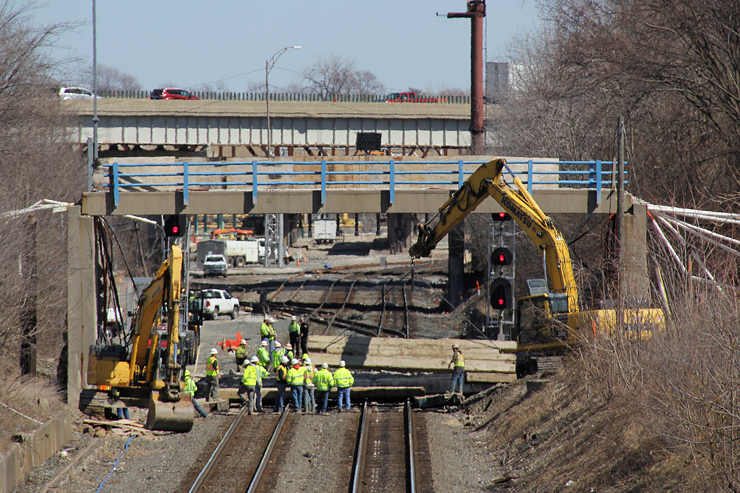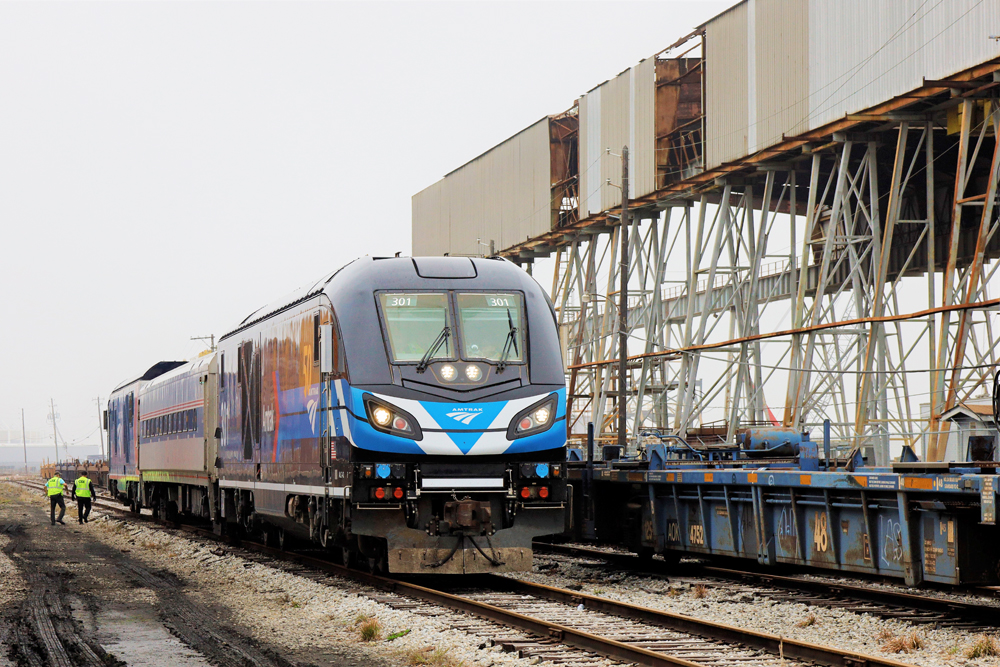TOLEDO, Ohio — A bridge collapsed onto a Norfolk Southern main line in Toledo on Wednesday, temporarily shutting down train traffic on the route to Chicago.
The Maumee Avenue bridge, undergoing repair work, collapsed about 2 p.m., dropping large slabs of concrete onto the tracks. No injuries were reported, the Toledo Blade reports.
Trains were operating past the bridge site by Wednesday evening, the paper reported.
The street was closed in November to begin repair work, and was scheduled to be closed for 270 days as part of a $3.9 million project which also includes rebuilding segment of Maumee and Emerald avenues. No information was immediately available on effect on the project schedule.
State Rep. Michael Sheehy (D-Toledo) told the Blade he was grateful there were no injuries, saying the collapse could have been “a tragedy of monumental proportions had it fallen on a train laden with hazardous materials.”















While this was a road bridge, I see too many 100+ year old rail bridges looking pretty shabby. Sometimes both freight and passenger RRs use them. A fund (tax, fee) needs to be established on off-road diesel (5-10 cents/gal) to make rebuilding/building bridges or any other related RR projects proceed quickly. Unexpected concrete failure can ruin your day.
Charles Bork. To expand to 3 or 4 tracks would require considerably more work than what is being done. This area is in a cut and would require quite a bit of dirt to be moved along with constructing retaining walls. It’s my understanding that the bridge work is being done to raise clearances.
As for the Maumee River bridge. The bridge itself is not the choke point. The T Center just west of the bridge is the choke point because of crew changes there. But the bridge is old, outdated and we’re waiting for the day it opens and doesn’t close. That’s when the price for ripping up huge portions of the former Toledo Terminal will come due
As I breathe and live in Toledo this story was to short. In my opinion the two bridges being worked on were accidents waiting to happen. NS has been a big problem to the construction teams. NS can not seem to its act together with the railroad safety flaggers being assigned or present when needed. Nothing can occur above rails if they are not there to ok the construction contractors. The bigger problem is the reconstruction of the six lane Anthony Wayne Trail bridge. If ODOT is to be believed the number of days lost to being able to work is phenomenal. NS is expanding capacity thru Toledo and it is needed! The bridges are being rebuilt to allow three or four tracks for NS to increase fluidity over the BIG MAUMEE river bridge that the Coast Guard says need to be replaced. The MAUMEE river bridge is a big choke point on NS.
Let’s just get ER done !
NS stock hit a 52 week high around Monday, and it is still above last week’s high. Quick recovery without injury is good, and it is also good to see the reopening benefiting Amtrak.
Hmm… sounds very similar to the one that UP had fall on to a vehicle a few years back (that one was due to poor concrete quality on the part of the contractor.)
Be interesting to see what the cause of this one was.
Representative Sheehy had been a brakeman on B&O/Chessie out of Toledo.
If there is a problem with the railroad’s flagmen not “being assigned or present when needed”, that may be partly the fault of the contractor. Were they paying for full time flagging coverage, or trying to cut costs by only asking for it intermittently to save costs, and doing so at the last minute?
The part of the story that surprises me is that the bridge was only closed in November. It sounds like it was far weaker than the engineers thought, and perhaps an accident ready to happen with a large vehicle on top. Or maybe the bureaucrats/politicians had been ignoring the engineering reports……
In the mid-1980’s a span of Detroit’s elevated people mover was being hoisted above West Fort Street (close to the site of the long-gone Fort Street Union Depot). Something went blooey and the span crashed onto the street below, breaking into pieces..
Fittingly, this was the very last span on the people mover project. The fabrication yard had already been closed and the equipment was already in the process of being hauled away.
No impact on Amtrak’s #29, #30, #48, #49. per https://asm.transitdocs.com
It’s been my experience that work like that only takes place with a RR supplied flagger on-site and holding a track occupancy permit. So, if done correctly, there is no chance of anything coming down on a train.
A bridge span collapse does cast a shadow of suspicion on this project.